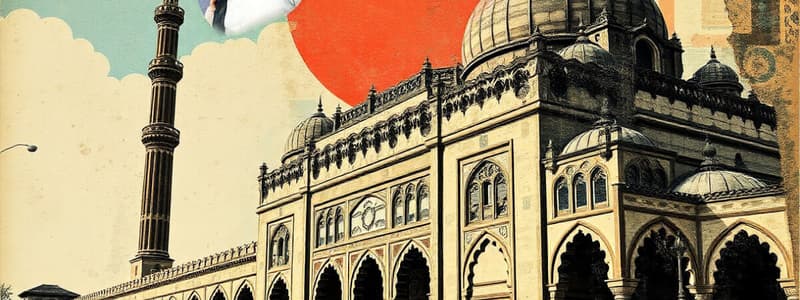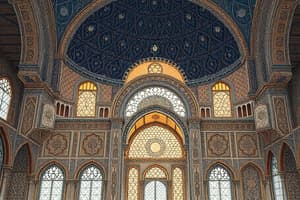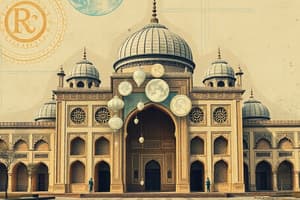Podcast
Questions and Answers
What does the Arabic term 'masjid' translate to in English, and what does it signify in the context of Islamic worship?
What does the Arabic term 'masjid' translate to in English, and what does it signify in the context of Islamic worship?
The Arabic term 'masjid' translates to 'place of prostration,' signifying a location for Muslims to submit to the will of God during prayer.
Identify two key architectural features that characterize Islamic architecture and explain their significance.
Identify two key architectural features that characterize Islamic architecture and explain their significance.
Geometric designs and pointed arches are key features; they symbolize the infinite nature of Allah and create an atmosphere of unity and spirituality.
Describe the historical origins of Islamic architecture and its relationship to the broader expressions of Islamic culture.
Describe the historical origins of Islamic architecture and its relationship to the broader expressions of Islamic culture.
Islamic architecture originated in the 7th century as a manifestation of Islamic principles, reflecting the cultural and religious life of its followers.
In addition to mosques, what types of structures are encompassed within Islamic architecture, and why is this diversity significant?
In addition to mosques, what types of structures are encompassed within Islamic architecture, and why is this diversity significant?
How does the decorative use of calligraphy in Islamic architecture reflect the values and beliefs of Islam?
How does the decorative use of calligraphy in Islamic architecture reflect the values and beliefs of Islam?
Flashcards
Mosque definition
Mosque definition
A Muslim house of worship, derived from the Arabic word "masjid" meaning "place of prostration."
Islamic Architecture Origins
Islamic Architecture Origins
A style of architecture rooted in Islamic principles, originating in the 7th century.
Islamic Architecture Elements
Islamic Architecture Elements
Includes geometric designs, pointed arches, domes, and decorative artwork like calligraphy.
Mosque's Purpose
Mosque's Purpose
Signup and view all the flashcards
Islamic Architecture Scope
Islamic Architecture Scope
Signup and view all the flashcards
Study Notes
Mosque Definition
- "Mosque" is an English word for a Muslim house of worship.
- The Arabic word for mosque is "masjid," meaning "place of prostration."
- During prayer, Muslims kneel and touch their foreheads to the ground, signifying submission to God.
Islamic Architecture
- Islamic architecture is a style primarily found in Arab states, Muslim-majority countries, and countries with Arab/Islamic histories (e.g., Spain, Portugal).
- Key elements include geometric designs, pointed arches, domes, and decorative artwork (like calligraphy).
- This architecture style demonstrates striking sculptural forms and ornate details, creating awe-inspiring structures.
Islamic Architecture's Origins
- Islamic architecture emerged as a physical expression of Islamic principles in the 7th century.
- This style encompasses both religious (mosques) and secular buildings, ranging from large-scale structures (mosques, fortresses, palaces, tombs, schools) to smaller features (fountains, public baths, homes).
- The tradition continues today.
Studying That Suits You
Use AI to generate personalized quizzes and flashcards to suit your learning preferences.




